Nursing Assignment: Developmental Similarities and Differences in Clinical Conditions
VerifiedAdded on 2023/06/03
|10
|2446
|174
AI Summary
This nursing assignment discusses the developmental similarities and differences between Anna and George, with two different clinical conditions but pertaining to somewhat similar symptoms like diarrhea, vomiting, fluid intolerance and abdominal cramping. SMART goals and nursing interventions have been developed based on the pathophysiology of both the conditions.
Contribute Materials
Your contribution can guide someone’s learning journey. Share your
documents today.
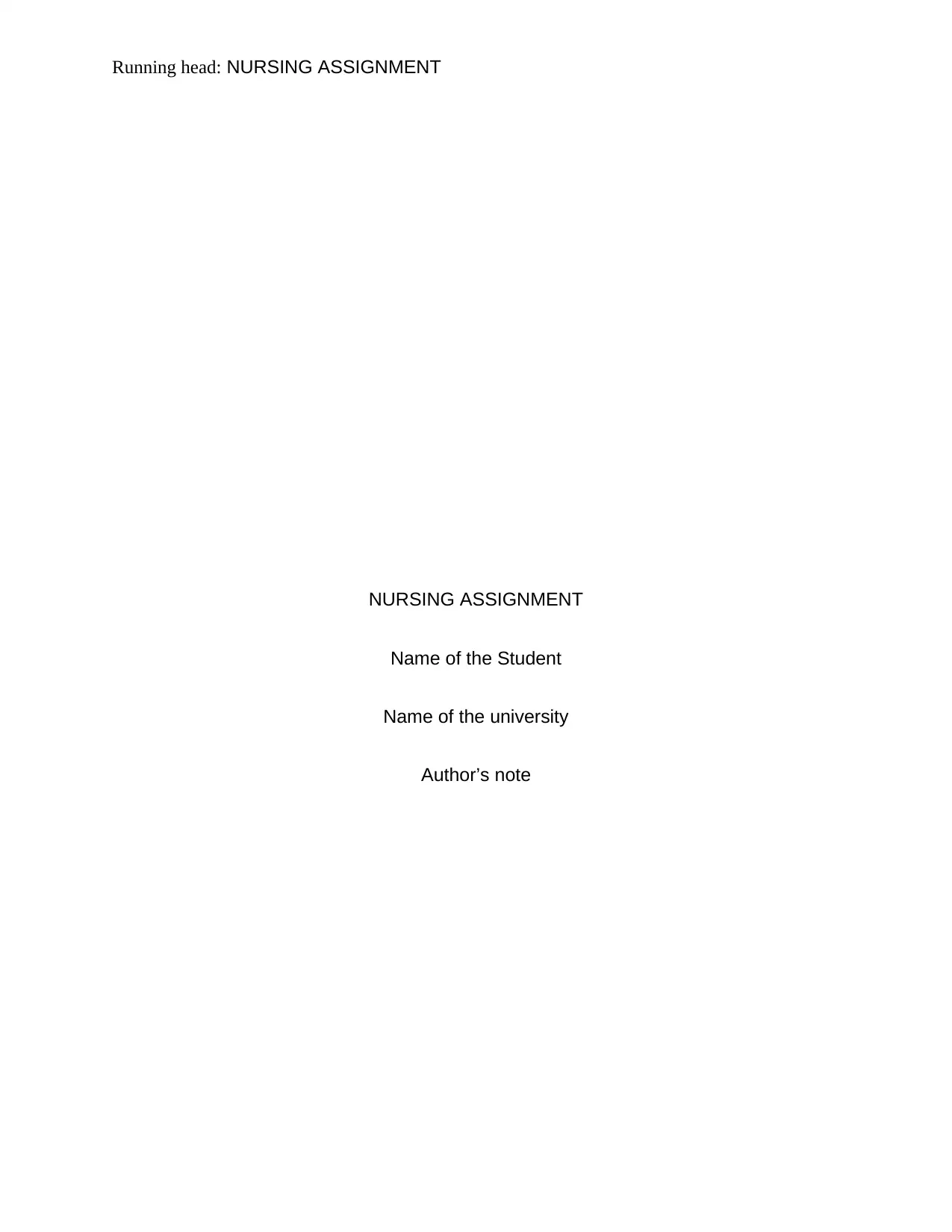
Running head: NURSING ASSIGNMENT
NURSING ASSIGNMENT
Name of the Student
Name of the university
Author’s note
NURSING ASSIGNMENT
Name of the Student
Name of the university
Author’s note
Secure Best Marks with AI Grader
Need help grading? Try our AI Grader for instant feedback on your assignments.
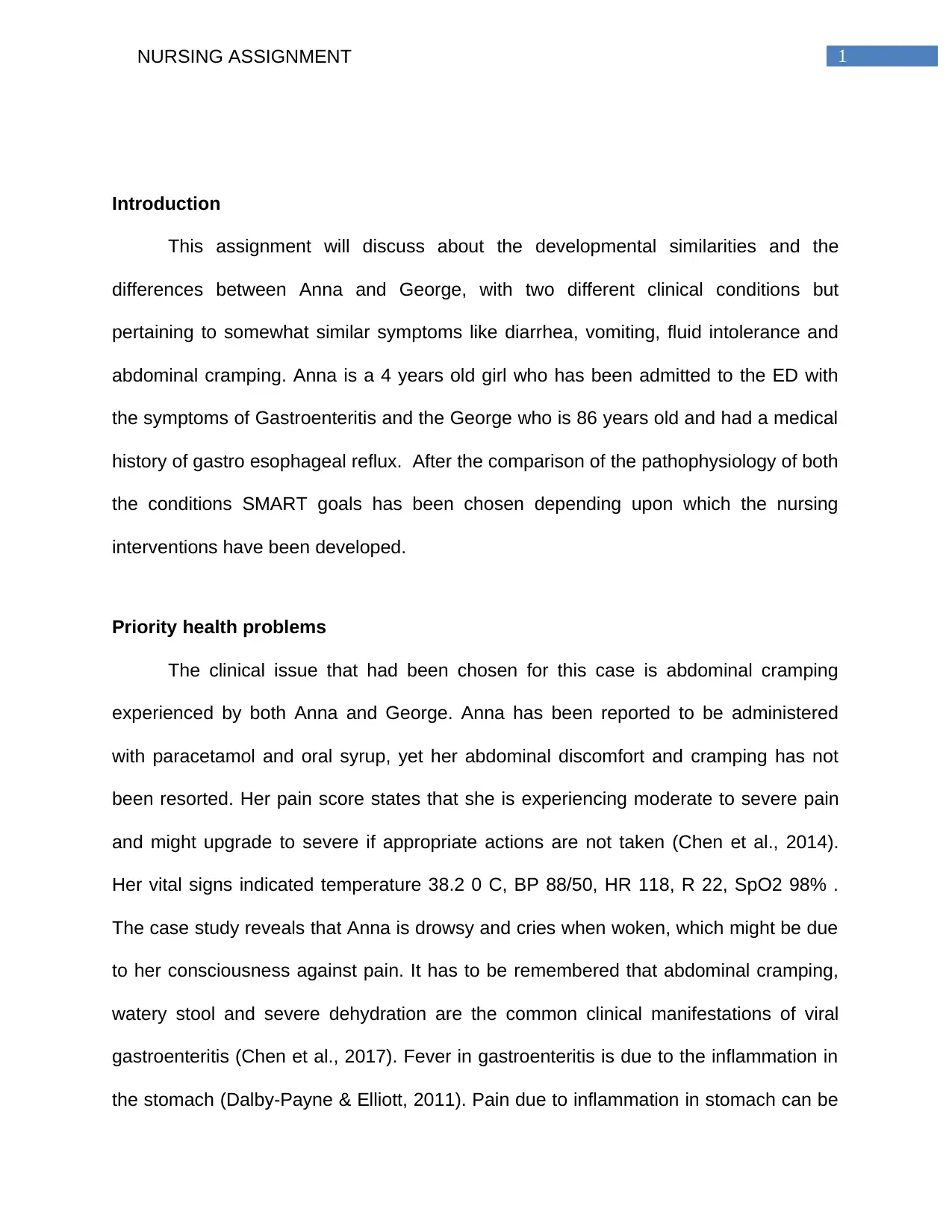
1NURSING ASSIGNMENT
Introduction
This assignment will discuss about the developmental similarities and the
differences between Anna and George, with two different clinical conditions but
pertaining to somewhat similar symptoms like diarrhea, vomiting, fluid intolerance and
abdominal cramping. Anna is a 4 years old girl who has been admitted to the ED with
the symptoms of Gastroenteritis and the George who is 86 years old and had a medical
history of gastro esophageal reflux. After the comparison of the pathophysiology of both
the conditions SMART goals has been chosen depending upon which the nursing
interventions have been developed.
Priority health problems
The clinical issue that had been chosen for this case is abdominal cramping
experienced by both Anna and George. Anna has been reported to be administered
with paracetamol and oral syrup, yet her abdominal discomfort and cramping has not
been resorted. Her pain score states that she is experiencing moderate to severe pain
and might upgrade to severe if appropriate actions are not taken (Chen et al., 2014).
Her vital signs indicated temperature 38.2 0 C, BP 88/50, HR 118, R 22, SpO2 98% .
The case study reveals that Anna is drowsy and cries when woken, which might be due
to her consciousness against pain. It has to be remembered that abdominal cramping,
watery stool and severe dehydration are the common clinical manifestations of viral
gastroenteritis (Chen et al., 2017). Fever in gastroenteritis is due to the inflammation in
the stomach (Dalby-Payne & Elliott, 2011). Pain due to inflammation in stomach can be
Introduction
This assignment will discuss about the developmental similarities and the
differences between Anna and George, with two different clinical conditions but
pertaining to somewhat similar symptoms like diarrhea, vomiting, fluid intolerance and
abdominal cramping. Anna is a 4 years old girl who has been admitted to the ED with
the symptoms of Gastroenteritis and the George who is 86 years old and had a medical
history of gastro esophageal reflux. After the comparison of the pathophysiology of both
the conditions SMART goals has been chosen depending upon which the nursing
interventions have been developed.
Priority health problems
The clinical issue that had been chosen for this case is abdominal cramping
experienced by both Anna and George. Anna has been reported to be administered
with paracetamol and oral syrup, yet her abdominal discomfort and cramping has not
been resorted. Her pain score states that she is experiencing moderate to severe pain
and might upgrade to severe if appropriate actions are not taken (Chen et al., 2014).
Her vital signs indicated temperature 38.2 0 C, BP 88/50, HR 118, R 22, SpO2 98% .
The case study reveals that Anna is drowsy and cries when woken, which might be due
to her consciousness against pain. It has to be remembered that abdominal cramping,
watery stool and severe dehydration are the common clinical manifestations of viral
gastroenteritis (Chen et al., 2017). Fever in gastroenteritis is due to the inflammation in
the stomach (Dalby-Payne & Elliott, 2011). Pain due to inflammation in stomach can be
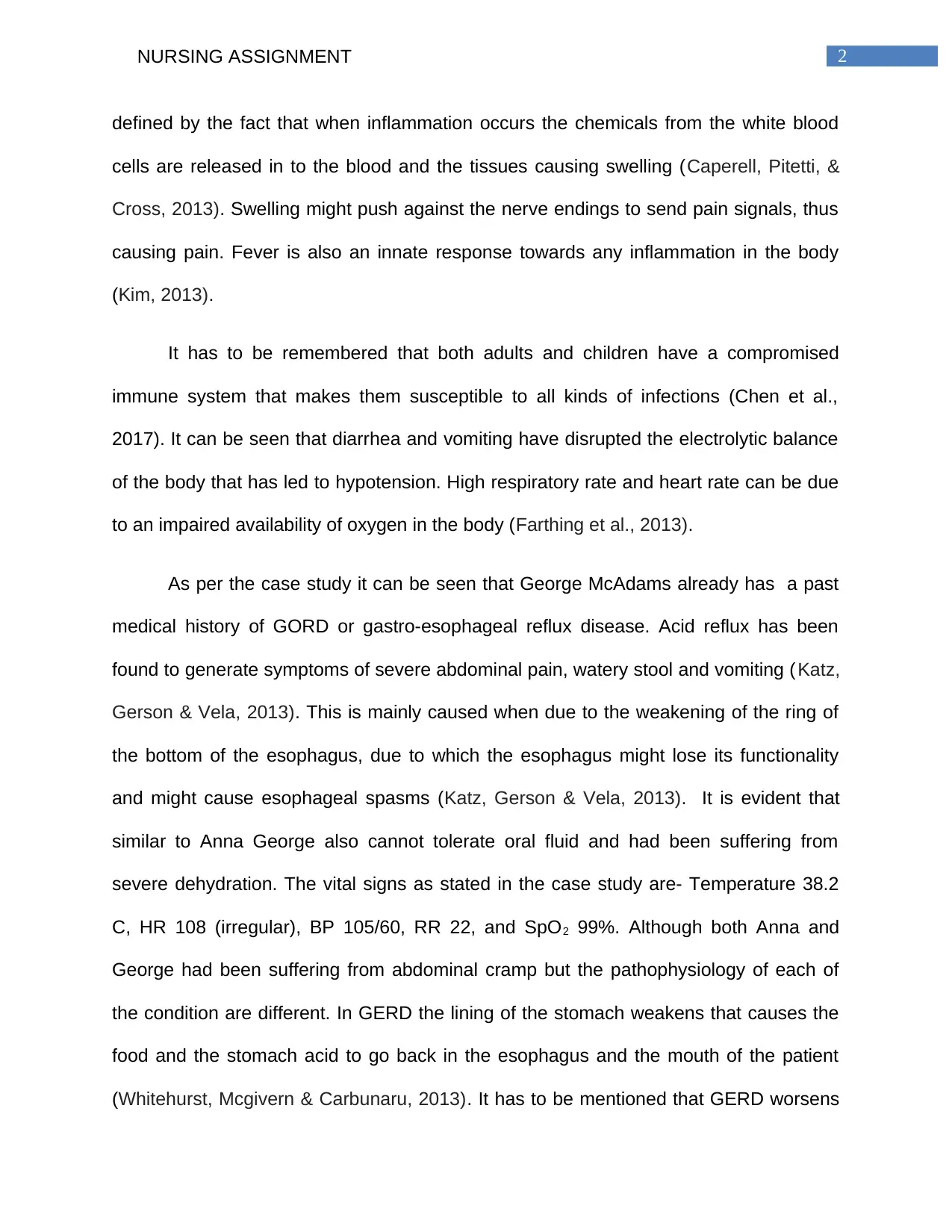
2NURSING ASSIGNMENT
defined by the fact that when inflammation occurs the chemicals from the white blood
cells are released in to the blood and the tissues causing swelling (Caperell, Pitetti, &
Cross, 2013). Swelling might push against the nerve endings to send pain signals, thus
causing pain. Fever is also an innate response towards any inflammation in the body
(Kim, 2013).
It has to be remembered that both adults and children have a compromised
immune system that makes them susceptible to all kinds of infections (Chen et al.,
2017). It can be seen that diarrhea and vomiting have disrupted the electrolytic balance
of the body that has led to hypotension. High respiratory rate and heart rate can be due
to an impaired availability of oxygen in the body (Farthing et al., 2013).
As per the case study it can be seen that George McAdams already has a past
medical history of GORD or gastro-esophageal reflux disease. Acid reflux has been
found to generate symptoms of severe abdominal pain, watery stool and vomiting ( Katz,
Gerson & Vela, 2013). This is mainly caused when due to the weakening of the ring of
the bottom of the esophagus, due to which the esophagus might lose its functionality
and might cause esophageal spasms (Katz, Gerson & Vela, 2013). It is evident that
similar to Anna George also cannot tolerate oral fluid and had been suffering from
severe dehydration. The vital signs as stated in the case study are- Temperature 38.2
C, HR 108 (irregular), BP 105/60, RR 22, and SpO2 99%. Although both Anna and
George had been suffering from abdominal cramp but the pathophysiology of each of
the condition are different. In GERD the lining of the stomach weakens that causes the
food and the stomach acid to go back in the esophagus and the mouth of the patient
(Whitehurst, Mcgivern & Carbunaru, 2013). It has to be mentioned that GERD worsens
defined by the fact that when inflammation occurs the chemicals from the white blood
cells are released in to the blood and the tissues causing swelling (Caperell, Pitetti, &
Cross, 2013). Swelling might push against the nerve endings to send pain signals, thus
causing pain. Fever is also an innate response towards any inflammation in the body
(Kim, 2013).
It has to be remembered that both adults and children have a compromised
immune system that makes them susceptible to all kinds of infections (Chen et al.,
2017). It can be seen that diarrhea and vomiting have disrupted the electrolytic balance
of the body that has led to hypotension. High respiratory rate and heart rate can be due
to an impaired availability of oxygen in the body (Farthing et al., 2013).
As per the case study it can be seen that George McAdams already has a past
medical history of GORD or gastro-esophageal reflux disease. Acid reflux has been
found to generate symptoms of severe abdominal pain, watery stool and vomiting ( Katz,
Gerson & Vela, 2013). This is mainly caused when due to the weakening of the ring of
the bottom of the esophagus, due to which the esophagus might lose its functionality
and might cause esophageal spasms (Katz, Gerson & Vela, 2013). It is evident that
similar to Anna George also cannot tolerate oral fluid and had been suffering from
severe dehydration. The vital signs as stated in the case study are- Temperature 38.2
C, HR 108 (irregular), BP 105/60, RR 22, and SpO2 99%. Although both Anna and
George had been suffering from abdominal cramp but the pathophysiology of each of
the condition are different. In GERD the lining of the stomach weakens that causes the
food and the stomach acid to go back in the esophagus and the mouth of the patient
(Whitehurst, Mcgivern & Carbunaru, 2013). It has to be mentioned that GERD worsens
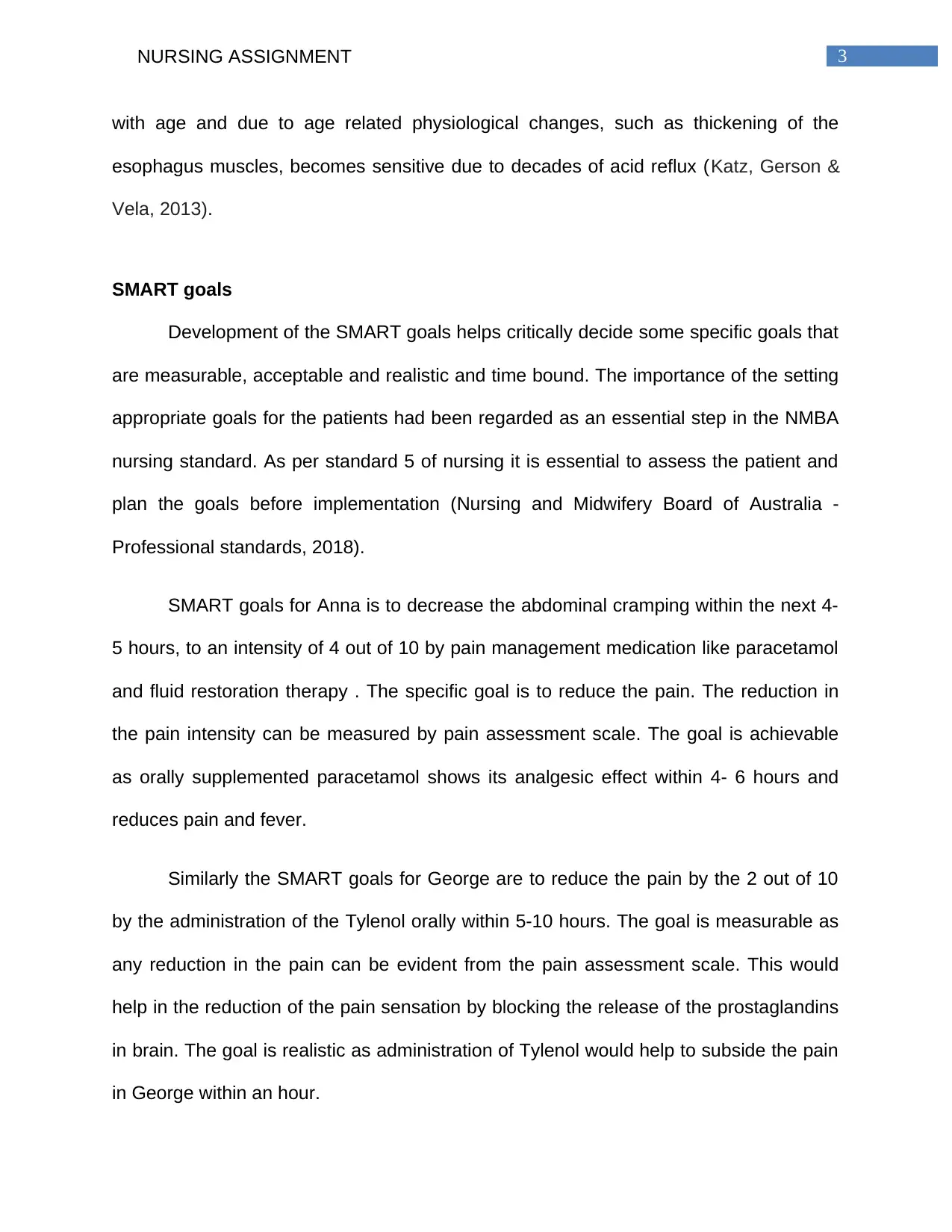
3NURSING ASSIGNMENT
with age and due to age related physiological changes, such as thickening of the
esophagus muscles, becomes sensitive due to decades of acid reflux (Katz, Gerson &
Vela, 2013).
SMART goals
Development of the SMART goals helps critically decide some specific goals that
are measurable, acceptable and realistic and time bound. The importance of the setting
appropriate goals for the patients had been regarded as an essential step in the NMBA
nursing standard. As per standard 5 of nursing it is essential to assess the patient and
plan the goals before implementation (Nursing and Midwifery Board of Australia -
Professional standards, 2018).
SMART goals for Anna is to decrease the abdominal cramping within the next 4-
5 hours, to an intensity of 4 out of 10 by pain management medication like paracetamol
and fluid restoration therapy . The specific goal is to reduce the pain. The reduction in
the pain intensity can be measured by pain assessment scale. The goal is achievable
as orally supplemented paracetamol shows its analgesic effect within 4- 6 hours and
reduces pain and fever.
Similarly the SMART goals for George are to reduce the pain by the 2 out of 10
by the administration of the Tylenol orally within 5-10 hours. The goal is measurable as
any reduction in the pain can be evident from the pain assessment scale. This would
help in the reduction of the pain sensation by blocking the release of the prostaglandins
in brain. The goal is realistic as administration of Tylenol would help to subside the pain
in George within an hour.
with age and due to age related physiological changes, such as thickening of the
esophagus muscles, becomes sensitive due to decades of acid reflux (Katz, Gerson &
Vela, 2013).
SMART goals
Development of the SMART goals helps critically decide some specific goals that
are measurable, acceptable and realistic and time bound. The importance of the setting
appropriate goals for the patients had been regarded as an essential step in the NMBA
nursing standard. As per standard 5 of nursing it is essential to assess the patient and
plan the goals before implementation (Nursing and Midwifery Board of Australia -
Professional standards, 2018).
SMART goals for Anna is to decrease the abdominal cramping within the next 4-
5 hours, to an intensity of 4 out of 10 by pain management medication like paracetamol
and fluid restoration therapy . The specific goal is to reduce the pain. The reduction in
the pain intensity can be measured by pain assessment scale. The goal is achievable
as orally supplemented paracetamol shows its analgesic effect within 4- 6 hours and
reduces pain and fever.
Similarly the SMART goals for George are to reduce the pain by the 2 out of 10
by the administration of the Tylenol orally within 5-10 hours. The goal is measurable as
any reduction in the pain can be evident from the pain assessment scale. This would
help in the reduction of the pain sensation by blocking the release of the prostaglandins
in brain. The goal is realistic as administration of Tylenol would help to subside the pain
in George within an hour.
Secure Best Marks with AI Grader
Need help grading? Try our AI Grader for instant feedback on your assignments.

4NURSING ASSIGNMENT
Interventions
The chosen priorities for drawing the interventions are pain management for both
Anna and George. However due to the different clinical issues of the two patients the
strategies might differ slightly.
The first step is the pharmacologic management of pain. Hence initially it is
necessary to assess the amount of pain followed by proper dosage of paracetamol,
considering her age and the risk factors (Macaluso & McNamara, 2012). Dosage
calculations should be done using proper algorithms and should be cross-checked to
prevent any drug related adverse reactions (Kim, 2013). The rationale for choosing
paracetamol for Anna is that it is a non-opoid analgesic with least side effects(
Parashar, Nelson, & Kang, 2013). Dosages for the paracetamol should be as per the
weight of the child are an important step while giving paracetamol. Patient less than 50
kg is limited to 3gms (Binder, Brown,Ramakrishna, & Young, 2014).
The case study also states that Anna had been suffering from fluid volume
deficit. Patients experiencing vomiting can become dehydrated and experience
abdominal pain (Binder, Brown,Ramakrishna, & Young, 2014). Hence it is necessary to
monitor the urinary output, electrolytes in the patient (Farthing et al., 2015). Children
who are severely dehydrated should be given with isotonic solutions (normal saline
0.9% or Ringer’s Lactate) (Farthing et al., 2015).
Similarly for George one of the interventions is the management of abdominal
pain. In order to manage pain in George Tylenol could be given (Katz, Gerson & Vela,
2013). Tylenol belongs to a class of analgesics that reduces the formation of the
Interventions
The chosen priorities for drawing the interventions are pain management for both
Anna and George. However due to the different clinical issues of the two patients the
strategies might differ slightly.
The first step is the pharmacologic management of pain. Hence initially it is
necessary to assess the amount of pain followed by proper dosage of paracetamol,
considering her age and the risk factors (Macaluso & McNamara, 2012). Dosage
calculations should be done using proper algorithms and should be cross-checked to
prevent any drug related adverse reactions (Kim, 2013). The rationale for choosing
paracetamol for Anna is that it is a non-opoid analgesic with least side effects(
Parashar, Nelson, & Kang, 2013). Dosages for the paracetamol should be as per the
weight of the child are an important step while giving paracetamol. Patient less than 50
kg is limited to 3gms (Binder, Brown,Ramakrishna, & Young, 2014).
The case study also states that Anna had been suffering from fluid volume
deficit. Patients experiencing vomiting can become dehydrated and experience
abdominal pain (Binder, Brown,Ramakrishna, & Young, 2014). Hence it is necessary to
monitor the urinary output, electrolytes in the patient (Farthing et al., 2015). Children
who are severely dehydrated should be given with isotonic solutions (normal saline
0.9% or Ringer’s Lactate) (Farthing et al., 2015).
Similarly for George one of the interventions is the management of abdominal
pain. In order to manage pain in George Tylenol could be given (Katz, Gerson & Vela,
2013). Tylenol belongs to a class of analgesics that reduces the formation of the
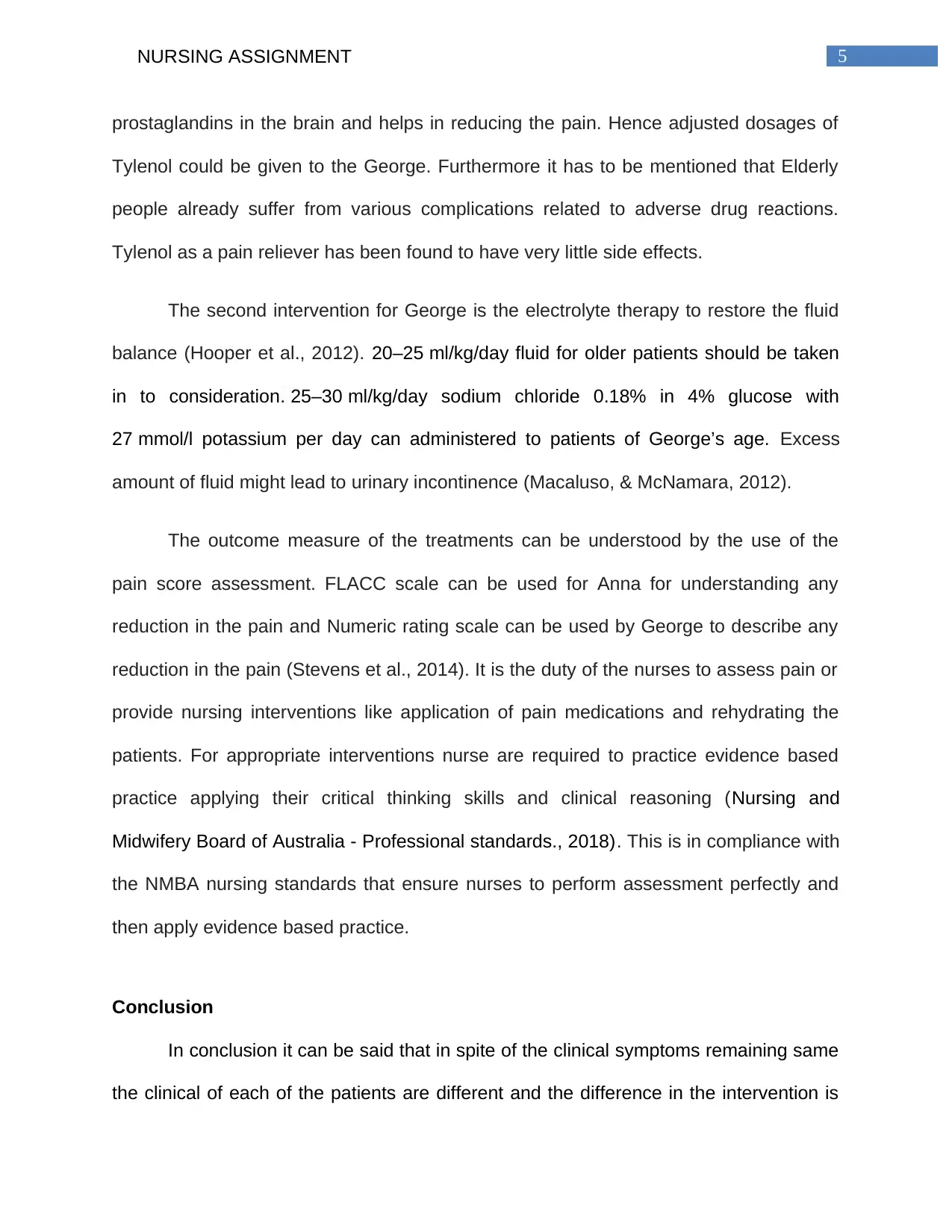
5NURSING ASSIGNMENT
prostaglandins in the brain and helps in reducing the pain. Hence adjusted dosages of
Tylenol could be given to the George. Furthermore it has to be mentioned that Elderly
people already suffer from various complications related to adverse drug reactions.
Tylenol as a pain reliever has been found to have very little side effects.
The second intervention for George is the electrolyte therapy to restore the fluid
balance (Hooper et al., 2012). 20–25 ml/kg/day fluid for older patients should be taken
in to consideration. 25–30 ml/kg/day sodium chloride 0.18% in 4% glucose with
27 mmol/l potassium per day can administered to patients of George’s age. Excess
amount of fluid might lead to urinary incontinence (Macaluso, & McNamara, 2012).
The outcome measure of the treatments can be understood by the use of the
pain score assessment. FLACC scale can be used for Anna for understanding any
reduction in the pain and Numeric rating scale can be used by George to describe any
reduction in the pain (Stevens et al., 2014). It is the duty of the nurses to assess pain or
provide nursing interventions like application of pain medications and rehydrating the
patients. For appropriate interventions nurse are required to practice evidence based
practice applying their critical thinking skills and clinical reasoning (Nursing and
Midwifery Board of Australia - Professional standards., 2018). This is in compliance with
the NMBA nursing standards that ensure nurses to perform assessment perfectly and
then apply evidence based practice.
Conclusion
In conclusion it can be said that in spite of the clinical symptoms remaining same
the clinical of each of the patients are different and the difference in the intervention is
prostaglandins in the brain and helps in reducing the pain. Hence adjusted dosages of
Tylenol could be given to the George. Furthermore it has to be mentioned that Elderly
people already suffer from various complications related to adverse drug reactions.
Tylenol as a pain reliever has been found to have very little side effects.
The second intervention for George is the electrolyte therapy to restore the fluid
balance (Hooper et al., 2012). 20–25 ml/kg/day fluid for older patients should be taken
in to consideration. 25–30 ml/kg/day sodium chloride 0.18% in 4% glucose with
27 mmol/l potassium per day can administered to patients of George’s age. Excess
amount of fluid might lead to urinary incontinence (Macaluso, & McNamara, 2012).
The outcome measure of the treatments can be understood by the use of the
pain score assessment. FLACC scale can be used for Anna for understanding any
reduction in the pain and Numeric rating scale can be used by George to describe any
reduction in the pain (Stevens et al., 2014). It is the duty of the nurses to assess pain or
provide nursing interventions like application of pain medications and rehydrating the
patients. For appropriate interventions nurse are required to practice evidence based
practice applying their critical thinking skills and clinical reasoning (Nursing and
Midwifery Board of Australia - Professional standards., 2018). This is in compliance with
the NMBA nursing standards that ensure nurses to perform assessment perfectly and
then apply evidence based practice.
Conclusion
In conclusion it can be said that in spite of the clinical symptoms remaining same
the clinical of each of the patients are different and the difference in the intervention is
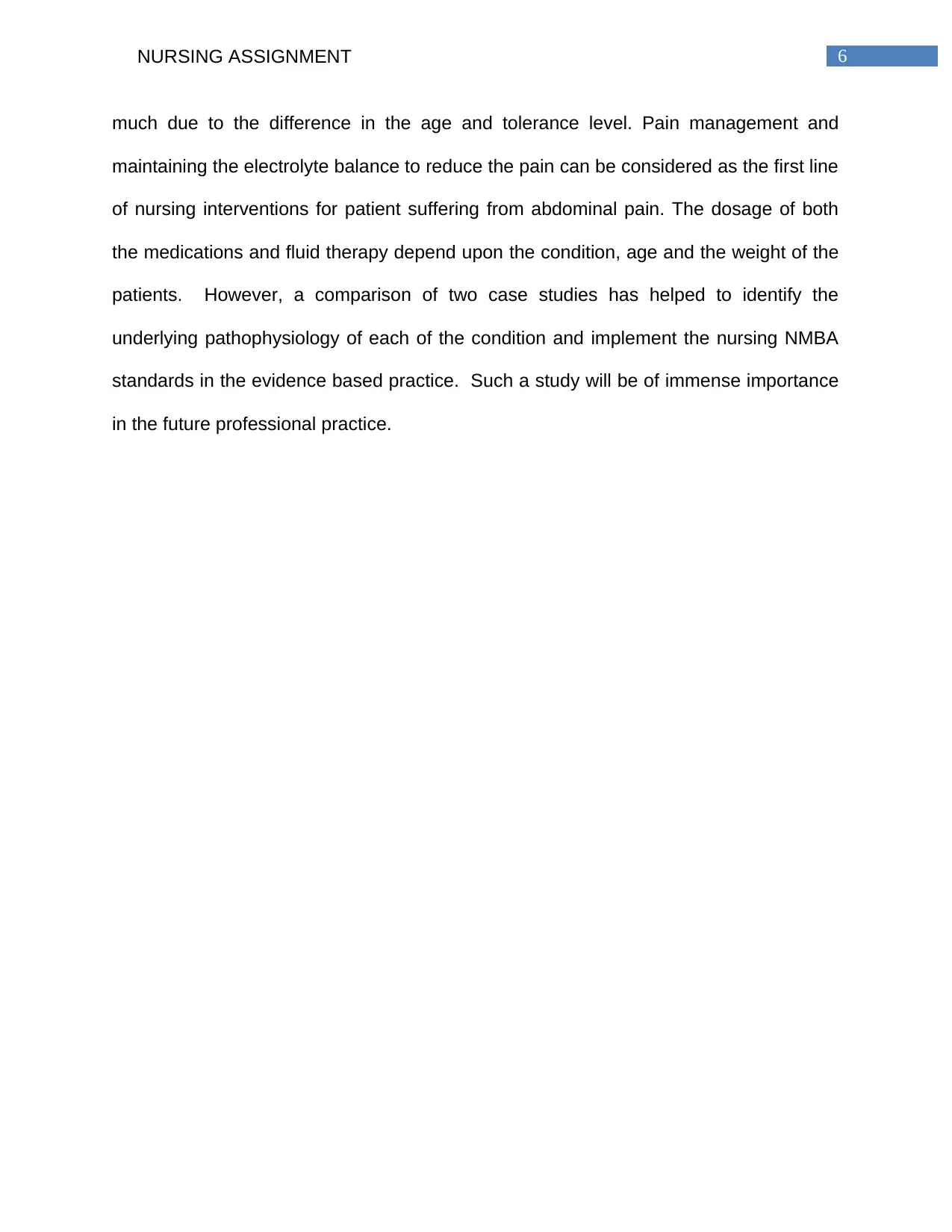
6NURSING ASSIGNMENT
much due to the difference in the age and tolerance level. Pain management and
maintaining the electrolyte balance to reduce the pain can be considered as the first line
of nursing interventions for patient suffering from abdominal pain. The dosage of both
the medications and fluid therapy depend upon the condition, age and the weight of the
patients. However, a comparison of two case studies has helped to identify the
underlying pathophysiology of each of the condition and implement the nursing NMBA
standards in the evidence based practice. Such a study will be of immense importance
in the future professional practice.
much due to the difference in the age and tolerance level. Pain management and
maintaining the electrolyte balance to reduce the pain can be considered as the first line
of nursing interventions for patient suffering from abdominal pain. The dosage of both
the medications and fluid therapy depend upon the condition, age and the weight of the
patients. However, a comparison of two case studies has helped to identify the
underlying pathophysiology of each of the condition and implement the nursing NMBA
standards in the evidence based practice. Such a study will be of immense importance
in the future professional practice.
Paraphrase This Document
Need a fresh take? Get an instant paraphrase of this document with our AI Paraphraser
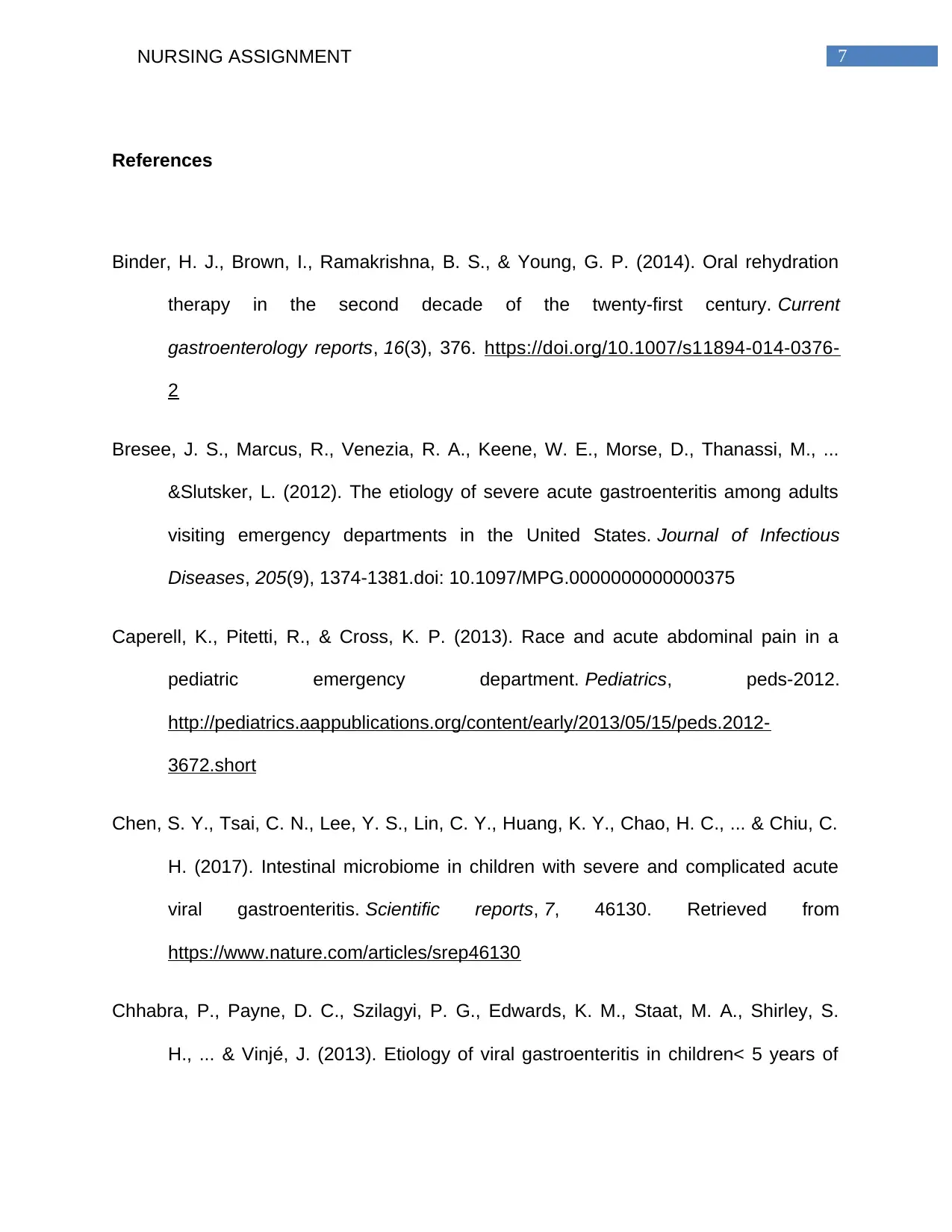
7NURSING ASSIGNMENT
References
Binder, H. J., Brown, I., Ramakrishna, B. S., & Young, G. P. (2014). Oral rehydration
therapy in the second decade of the twenty-first century. Current
gastroenterology reports, 16(3), 376. https://doi.org/10.1007/s11894-014-0376-
2
Bresee, J. S., Marcus, R., Venezia, R. A., Keene, W. E., Morse, D., Thanassi, M., ...
&Slutsker, L. (2012). The etiology of severe acute gastroenteritis among adults
visiting emergency departments in the United States. Journal of Infectious
Diseases, 205(9), 1374-1381.doi: 10.1097/MPG.0000000000000375
Caperell, K., Pitetti, R., & Cross, K. P. (2013). Race and acute abdominal pain in a
pediatric emergency department. Pediatrics, peds-2012.
http://pediatrics.aappublications.org/content/early/2013/05/15/peds.2012-
3672.short
Chen, S. Y., Tsai, C. N., Lee, Y. S., Lin, C. Y., Huang, K. Y., Chao, H. C., ... & Chiu, C.
H. (2017). Intestinal microbiome in children with severe and complicated acute
viral gastroenteritis. Scientific reports, 7, 46130. Retrieved from
https://www.nature.com/articles/srep46130
Chhabra, P., Payne, D. C., Szilagyi, P. G., Edwards, K. M., Staat, M. A., Shirley, S.
H., ... & Vinjé, J. (2013). Etiology of viral gastroenteritis in children< 5 years of
References
Binder, H. J., Brown, I., Ramakrishna, B. S., & Young, G. P. (2014). Oral rehydration
therapy in the second decade of the twenty-first century. Current
gastroenterology reports, 16(3), 376. https://doi.org/10.1007/s11894-014-0376-
2
Bresee, J. S., Marcus, R., Venezia, R. A., Keene, W. E., Morse, D., Thanassi, M., ...
&Slutsker, L. (2012). The etiology of severe acute gastroenteritis among adults
visiting emergency departments in the United States. Journal of Infectious
Diseases, 205(9), 1374-1381.doi: 10.1097/MPG.0000000000000375
Caperell, K., Pitetti, R., & Cross, K. P. (2013). Race and acute abdominal pain in a
pediatric emergency department. Pediatrics, peds-2012.
http://pediatrics.aappublications.org/content/early/2013/05/15/peds.2012-
3672.short
Chen, S. Y., Tsai, C. N., Lee, Y. S., Lin, C. Y., Huang, K. Y., Chao, H. C., ... & Chiu, C.
H. (2017). Intestinal microbiome in children with severe and complicated acute
viral gastroenteritis. Scientific reports, 7, 46130. Retrieved from
https://www.nature.com/articles/srep46130
Chhabra, P., Payne, D. C., Szilagyi, P. G., Edwards, K. M., Staat, M. A., Shirley, S.
H., ... & Vinjé, J. (2013). Etiology of viral gastroenteritis in children< 5 years of
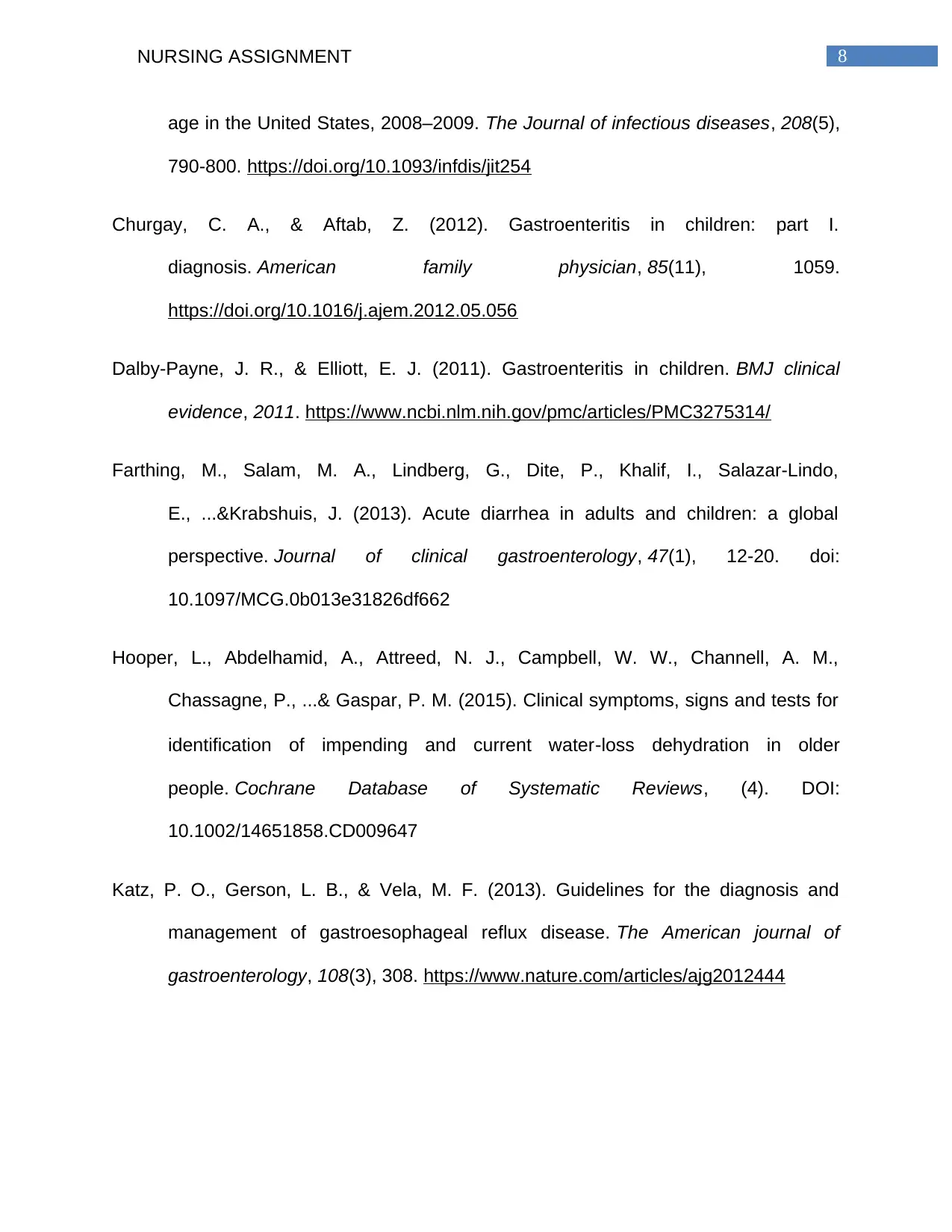
8NURSING ASSIGNMENT
age in the United States, 2008–2009. The Journal of infectious diseases, 208(5),
790-800. https://doi.org/10.1093/infdis/jit254
Churgay, C. A., & Aftab, Z. (2012). Gastroenteritis in children: part I.
diagnosis. American family physician, 85(11), 1059.
https://doi.org/10.1016/j.ajem.2012.05.056
Dalby-Payne, J. R., & Elliott, E. J. (2011). Gastroenteritis in children. BMJ clinical
evidence, 2011. https://www.ncbi.nlm.nih.gov/pmc/articles/PMC3275314/
Farthing, M., Salam, M. A., Lindberg, G., Dite, P., Khalif, I., Salazar-Lindo,
E., ...&Krabshuis, J. (2013). Acute diarrhea in adults and children: a global
perspective. Journal of clinical gastroenterology, 47(1), 12-20. doi:
10.1097/MCG.0b013e31826df662
Hooper, L., Abdelhamid, A., Attreed, N. J., Campbell, W. W., Channell, A. M.,
Chassagne, P., ...& Gaspar, P. M. (2015). Clinical symptoms, signs and tests for
identification of impending and current water‐loss dehydration in older
people. Cochrane Database of Systematic Reviews, (4). DOI:
10.1002/14651858.CD009647
Katz, P. O., Gerson, L. B., & Vela, M. F. (2013). Guidelines for the diagnosis and
management of gastroesophageal reflux disease. The American journal of
gastroenterology, 108(3), 308. https://www.nature.com/articles/ajg2012444
age in the United States, 2008–2009. The Journal of infectious diseases, 208(5),
790-800. https://doi.org/10.1093/infdis/jit254
Churgay, C. A., & Aftab, Z. (2012). Gastroenteritis in children: part I.
diagnosis. American family physician, 85(11), 1059.
https://doi.org/10.1016/j.ajem.2012.05.056
Dalby-Payne, J. R., & Elliott, E. J. (2011). Gastroenteritis in children. BMJ clinical
evidence, 2011. https://www.ncbi.nlm.nih.gov/pmc/articles/PMC3275314/
Farthing, M., Salam, M. A., Lindberg, G., Dite, P., Khalif, I., Salazar-Lindo,
E., ...&Krabshuis, J. (2013). Acute diarrhea in adults and children: a global
perspective. Journal of clinical gastroenterology, 47(1), 12-20. doi:
10.1097/MCG.0b013e31826df662
Hooper, L., Abdelhamid, A., Attreed, N. J., Campbell, W. W., Channell, A. M.,
Chassagne, P., ...& Gaspar, P. M. (2015). Clinical symptoms, signs and tests for
identification of impending and current water‐loss dehydration in older
people. Cochrane Database of Systematic Reviews, (4). DOI:
10.1002/14651858.CD009647
Katz, P. O., Gerson, L. B., & Vela, M. F. (2013). Guidelines for the diagnosis and
management of gastroesophageal reflux disease. The American journal of
gastroenterology, 108(3), 308. https://www.nature.com/articles/ajg2012444

9NURSING ASSIGNMENT
Kim, J. S. (2013). Acute abdominal pain in children. Pediatric gastroenterology,
hepatology & nutrition, 16(4), 219-224.
https://doi.org/10.5223/pghn.2013.16.4.219
Macaluso, C. R., & McNamara, R. M. (2012). Evaluation and management of acute
abdominal pain in the emergency department. International journal of general
medicine, 5, 789. doi: 10.2147/IJGM.S25936
Nursing and Midwifery Board of Australia - Professional standards. (2018). Retrieved
from https://www.nursingmidwiferyboard.gov.au/codes-guidelines-statements/
professional-standards.aspx
Parashar, U. D., Nelson, E. A., & Kang, G. (2013). Diagnosis, management, and
prevention of rotavirus gastroenteritis in children. Bmj, 347(7204), 1-10. doi:
10.1097/MCG.0b013e31826df662
Stevens, B. J., Harrison, D., Rashotte, J., Yamada, J., Abbott, L. K., Coburn, G., ... & Le
May, S. (2012). Pain assessment and intensity in hospitalized children in
Canada. The Journal of Pain, 13(9), 857-865.
https://doi.org/10.1016/j.jpain.2012.05.010
Whitehurst, T. K., Mcgivern, J. P., & Carbunaru, R. (2013). U.S. Patent No. 8,452,407.
Washington, DC: U.S. Patent and Trademark Office.
Kim, J. S. (2013). Acute abdominal pain in children. Pediatric gastroenterology,
hepatology & nutrition, 16(4), 219-224.
https://doi.org/10.5223/pghn.2013.16.4.219
Macaluso, C. R., & McNamara, R. M. (2012). Evaluation and management of acute
abdominal pain in the emergency department. International journal of general
medicine, 5, 789. doi: 10.2147/IJGM.S25936
Nursing and Midwifery Board of Australia - Professional standards. (2018). Retrieved
from https://www.nursingmidwiferyboard.gov.au/codes-guidelines-statements/
professional-standards.aspx
Parashar, U. D., Nelson, E. A., & Kang, G. (2013). Diagnosis, management, and
prevention of rotavirus gastroenteritis in children. Bmj, 347(7204), 1-10. doi:
10.1097/MCG.0b013e31826df662
Stevens, B. J., Harrison, D., Rashotte, J., Yamada, J., Abbott, L. K., Coburn, G., ... & Le
May, S. (2012). Pain assessment and intensity in hospitalized children in
Canada. The Journal of Pain, 13(9), 857-865.
https://doi.org/10.1016/j.jpain.2012.05.010
Whitehurst, T. K., Mcgivern, J. P., & Carbunaru, R. (2013). U.S. Patent No. 8,452,407.
Washington, DC: U.S. Patent and Trademark Office.
1 out of 10
Your All-in-One AI-Powered Toolkit for Academic Success.
+13062052269
info@desklib.com
Available 24*7 on WhatsApp / Email
![[object Object]](/_next/static/media/star-bottom.7253800d.svg)
Unlock your academic potential
© 2024 | Zucol Services PVT LTD | All rights reserved.

